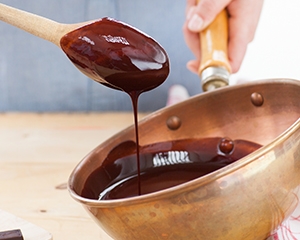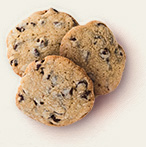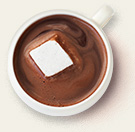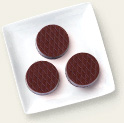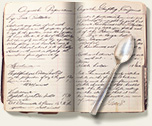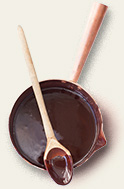Problem Solving
PROBLEM SOLVING
CHOCOLATE BLOOM
Problem: Dull, white streaked or blotched surface
Potential resolutions: Chocolate Bloom can be diagnosed as either sugar bloom, or fat bloom. If the white film melts to the touch, it is likely due to fat migration caused by improper storage, poor temper, or presence of other fat systems like oil in nut-based fillings. If the white film is grainy, dusty appearing, and does not melt to the touch, it is likely sugar bloom. Sugar bloom is caused by changes in environmental factors; a humid storage environment or temperature shocks from cold to warm. These changes will cause condensation to form on the exterior of the product, leading to the sugar and water (condensate) to interact, leaving a white and ashy surface. If freezing products, keeping the chocolate well wrapped until it reaches room temperature can help alleviate condensation issues. Additional guidance on freezing chocolate is here.
If fat bloom is due to improper storage, the storage temperature is likely too high or drastically fluctuates. It is recommended that chocolate is stored at 60-70°F, <50% relative humidity in a well-ventilated area. If the white appearance is due to poor temper, refer to the tempering guidance here. If there are other fats in the confection other than cocoa butter and milk fat, additional guidance is here.
CHOCOLATE IS DIFFICULT TO RELEASE FROM THE MOULD
Problem: Chocolate is sticking to the mould, either difficult to de-mould, or completely stuck!If the chocolate is sticking the moulds, 2 main issues could be at hand
- Poor tempering
- Moisture on Moulds
Potential resolutions:
Tempering: To ensure proper tempering procedures, follow the guidance outlined here for the product being tempered. Ensure correct temperatures are being reached, with frequent stirring throughout the process. Stirring of the chocolate as it cools to temperature ensures proper crystal formation. If chocolate is not properly tempered, it will not crystallize uniformly and will not readily contract from the mould upon cooling.
Moulds: Ensure the moulds are clean, free from residual chocolate and oils, and completely dry before filling with well-tempered chocolate. Mould temperature is also critical – be sure the mould temperature is neutral to touch, approximately the temperature of the tempered chocolate. If the mould is too warm, this may cause the chocolate to fall out of temper. For shell-moulded confections, if the chocolate shell is too thin, sufficient contraction may not occur upon cooling, leading to the chocolate readily release from the mould. A thicker, more viscous chocolate, or multiple applications of chocolate can help get a thicker chocolate shell.
Control the Environment: Cool the chocolate in an area with good air circulation to ensure that the mould cools on all sides where heat isn’t trapped on the bottom. When heat is trapped, cooling happens unequally causing chocolate to stick to the mould. Allow ample time, with good air circulation for full cooling and contraction from the mould.
CHOCOLATE IS SLOW TO SET
Problem: Chocolate is not setting/still soft to touch
Potential resolutions: Confirm correct temperatures are being reached during the tempering process. Be sure that frequent agitation or mixing occurs as the chocolate cools. Well-tempered chocolate has proper crystal formation giving shine, a strong snap. Chocolate that is soft to touch at recommended temperature and humidity is likely due to it having poor temper and lack of correct crystal formation. Our suggestion is to save the slow setting chocolate, and remelt it completely to a temperature of 125°-130°F. Once completely melted to temperature range, follow the tempering instructions found here again. Chocolate that is well-tempered will set up relatively fast and give a shiny finish and notable snap. Chocolate that is poorly tempered and slow to set does not have the optimal amount of crystal seed. Once chocolate is properly tempered, it needs to be thoroughly cooled with a good amount of air circulation to remove residual heat of crystallization.
CHOCOLATE SHELL IS TOO THICK
Problem: The chocolate shell of filled confections is too thick
Potential resolutions: A thick chocolate (high viscosity) is slower to fully coat and flow out of a mould to create a shell. Greater effort in tapping or shaking the mould is needed to thoroughly coat the mould with chocolate, remove air bubbles, and remove excess chocolate in creating the shell. Guittard Organic Baking Wafers and Baking Bars include a range of low viscosity chocolates, great for achieving a thin, delicate chocolate shell. Adding melted cocoa butter to chocolate on hand, will aide in lowering viscosity.
ADDING OTHER FATS & OILS TO CHOCOLATE
Problem: The chocolate is thicker, more viscous than expected or needed for a particular application
Potential resolutions: Cocoa butter and other fats and oils may be added to your favorite chocolate to lower the viscosity and result in a thinner chocolate. Cocoa butter can be added to chocolate in the amount needed to reach your ideal flow behavior. If this is the first time adding cocoa butter to your chocolate, we suggest fully melting the cocoa butter and chocolate, separately, and adding the cocoa butter 1% by mass at a time and thoroughly mixing between additions, while being sure not to incorporate too much air into the chocolate. If adding fats or oils other than cocoa butter to chocolate, a bit of fat chemistry is helpful in choosing and understanding the effect of the addition on the chocolate. Blending other fats and oils into chocolate, whether intentionally or unintentionally (due to nut inclusions or confectionery centers), will result in softer, quick-to-melt chocolate that will likely be more susceptible to bloom. For this reason, tropical, lauric fats like coconut and palm, as well as lower melting nut oils should be used very sparingly in chocolate.
